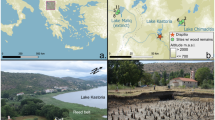Abstract
HOPANES are ubiquitous in petroleum source rocks and crude oils. These compounds are thought to be derived mainly from a specific oxygenated precursor, bacteriohopanetetrol, found in the cell walls of prokaryotic organisms1, and commonly occur as a homologous series of structurally related isomers containing between 27 and 35 carbon atoms; hopanes containing more than 35 carbon atoms have also been reported2. Hopanes and other pentacyclic triterpanes are relatively resistant to microbial degradation3–5, making them useful in correlating moderately bio-degraded oils to their source rocks5. During the advanced stages of biodegradation, however, these compounds can be altered, being converted either to 25-normethyl homologues4 or to other, as yet uncharacterized, products. Selective removal of individual compounds may occur; for example, 22R extended homohopanes may be degraded whereas 22S epimers are preserved6–8. Here we report an unusual biodegradation sequence of pentacyclic triterpanes in tar sands from the Pt Arena Formation, California, in which the 22S and 22R isomers of the 17α(H), 21β(H)–C35 extended hopanes are selectively preserved. Demethylation at the C25 position is observed for most hopanes in severely biodegraded samples, with the exception of the C35 extended hopanes. Two commonly occurring trisnorhopanes9, designated Ts (18α(H), 21β(H)-22, 29, 30-trisnorneohopane) and Tm (17α(H), 21β(H)-22, 29, 30-tris-norhopane), also seem resistant to degradation. These findings, together with previous studies of crude-oil biodegradation, imply that biodegradative alteration of hopanes can proceed through numerous pathways, which can result in widely differing distributions.
This is a preview of subscription content, access via your institution
Access options
Subscribe to this journal
Receive 51 print issues and online access
$199.00 per year
only $3.90 per issue
Buy this article
- Purchase on Springer Link
- Instant access to full article PDF
Prices may be subject to local taxes which are calculated during checkout
Similar content being viewed by others
References
Ourisson, G., Albrecht, P. & Rohmer, M. Pure appl. Sci. 10, 709–729 (1979).
Rullkotter, J. & Philp, P. Nature 292, 616–618 (1982).
Seifert, W. K. & Moldowan, J. M. Geochim. cosmochim. Acta 43, 111–126 (1979).
Volkman, J. K., Alexander, R., Kagi, R. I. & Woodhouse, G. W. Geochim. cosmochim. Acta 47, 785–794 (1983).
Connan, J. in Advances in Petroleum Geochemistry Vol. 1 (eds Brooks, J. & Welte, D.) 299–335 (Academic, London, 1984).
Hoffman, C. F. & Strausz, O. P. Am. Ass. Petrol. Geol. 70, 1113–1128 1986.
Seifert, W. K., Moldowan, J. M. & Demaison, D. J. Org. Geochem. 6, 633–643 (1984).
Goodwin, N. S., Park, P. J. D. & Rawlinson, T. in Advances in Organic Geochemistry 1981 (eds Bjoroy, M. et al.) 650–658 (Wiley, Ohichester, 1983).
Seifert, W. K. & Moldowan, J. M. Geochim. cosmochim. Acta 42, 77–95 (1978).
Orr, W. I. Org. Geochem. 10, 499–516 (1986).
Magoon, L. & Isaacs, C. M. in Petroleum Generation and Occurrence in the Miocene Monterey Formation. California (ed. Isaacs, C. M. et al.) 201–211 (Soc. Econ. Paleontologists Mineralogists, 1983).
Bailey, N. J. M., Jobson, A. M. & Rogers, M. A. Chem. Geol. 11, 203–211 (1973).
Sofer, Z. Org. Geochem. 13, 939–945 (1988).
Curiale, J. A., Cameron, D. & Davis, D. V. Geochim. cosmochim. Acta 49, 271–288 (1985).
Grantham, P. J., Posthuma, J. & de Groot, K. in Advances in Organic Geochemistry 1979 (eds Douglas, A. G. & Maxwell, J. R.) 29–38 (Pergamon, Oxford, 1980).
Connan, J. & Dessort, D. Org. Geochem. 11, 103–113 (1987).
ten Haven, H. L., de Leeuw, J. W. & Schenck, P. A. Geochim. cosmochim. Acta 49, 2181–2191 (1985).
ten Haven, H. L. et al. in Lacustrine Petroleum Source Rocks, Geol. Soc. Spec. Publ. 40 (eds Fleet, A. J. et al.) 123–140 (Blackwell Scientific, Oxford, 1988).
Rubinstein, I., Strausz, O. P., Spyckerelle, C., Crawford, R. J. & Westlake, D. W. S. Geochim. cosmochim. Acta 41, 1341–1353 (1977).
Kennicutt, M. C. & Brooks, J. M. Appl. Geochem. 3, 573–582 (1988).
Author information
Authors and Affiliations
Rights and permissions
About this article
Cite this article
Requejo, A., Halpern, H. An unusual hopane biodegradation sequence in tar sands from the Pt Arena (Monterey) Formation. Nature 342, 670–673 (1989). https://doi.org/10.1038/342670a0
Received:
Accepted:
Issue Date:
DOI: https://doi.org/10.1038/342670a0
This article is cited by
-
Hydrocarbon distribution along the Soapaga thrust (Eastern Cordillera, Colombia) based on new strategic geochemistry samples
Acta Geochimica (2022)
-
Response of 17α(H)-diahopanes and 18α(H)-neohopanes to maturity in lacustrine source rocks derived from the Songliao Basin, NE China
Arabian Journal of Geosciences (2020)
-
Biodegradation and the origin of surface bitumens in the Palaeocene Kolosh Formation, Northern Iraq
Arabian Journal of Geosciences (2020)
-
The effect of biodegradation on gammacerane in crude oils
Biodegradation (2017)
-
Changes in Concentration and Distribution of Biomarkers in Biodegraded Oils from Dongying Depression, China
Applied Biochemistry and Biotechnology (2015)
Comments
By submitting a comment you agree to abide by our Terms and Community Guidelines. If you find something abusive or that does not comply with our terms or guidelines please flag it as inappropriate.



